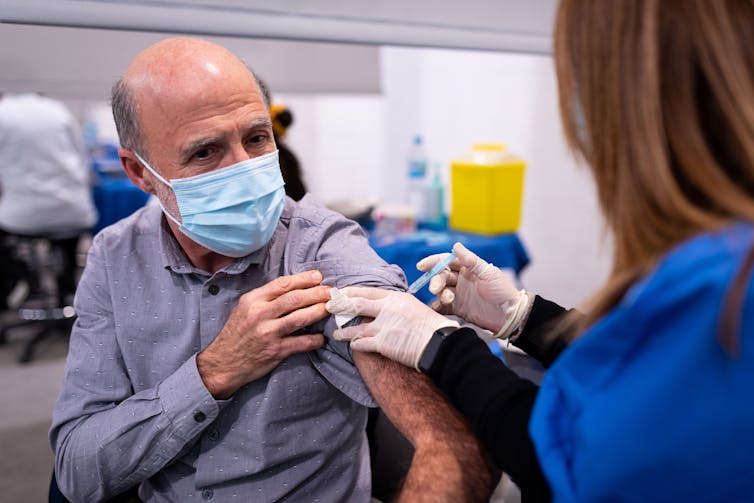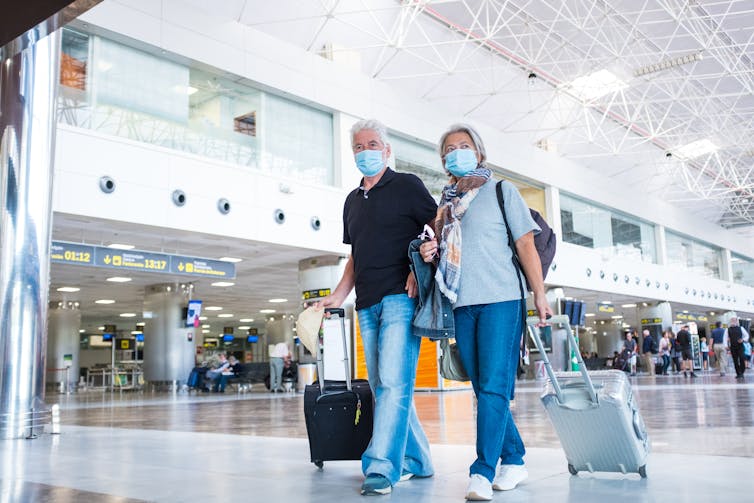
With Australians learning to live with COVID and resuming international travel, cases of influenza are steadily rising.
Getting a flu shot reduces your chance of catching the flu caused by four flu virus strains covered by the vaccine, and reduces the risk of severe complications and hospitalisations.
An annual flu vaccine is recommended for adults and children six months and older – unless you have a history of anaphylactic reactions to the vaccine or your doctor advises against it.
There are different brands and types of flu vaccines. So when booking in for your shot, your health provider will discuss the best option for you.
What are the options?
If you’re over 65, you’re likely to be offered an “adjuvanted” (Fluad Quad) vaccine. Those aged over 60 can also access the high-dose vaccine (Fluzone High-Dose Quad).
If you want to avoid vaccines made with eggs, you can ask for a cell-based vaccine (Flucelvax Quad).
But for most other Australians, there isn’t much of a difference between brands – Vaxigrip Tetra, Fluarix Tetra, Afluria Quad, FluQuadri, Influvac Tetra – aside from their suitability for different age groups.
GPs and pharmacists will generally stock one or two of these brands or whichever their state or territory governments supplies.
Read more: Should I get the 2022 flu vaccine? And how effective is it?
Unlike in previous years, all eight flu vaccines available this year are “quadrivalent”, meaning each vaccine protects against four strains of flu viruses.
The strains are predicted to be the most commonly circulating strains, based on trends observed in the Northern Hemisphere winter.
Flu vaccines are “inactivated”, which means they don’t contain live viruses and can never give anyone the flu.
Over 65s
For people 65 years and older, “adjuvanted” or immune-boosting (Fluad Quad®) or high-dose vaccines (Fluzone High-Dose Quad®) are recommended, as older people tend to have weaker immune systems.
Vaccines work by activating a person’s own immune system. The “adjuvanted” vaccine activates a stronger immune response and is therefore more effective at preventing the flu in older age groups than the standard vaccines.
High-dose vaccines deliver a higher dose than standard flu vaccines and are also more effective than the standard vaccines at reducing transmission and preventing severe disease in older age groups.
Adjuvanted vaccines are free for over-65s under the National Immunisation Program.
If you’re 60 or over, you can choose a high-dose vaccine, although you may have to pay for it, depending on local government programs.

Cell-based vaccines don’t use eggs
The flu vaccines are either egg-based or cell-based. Traditionally, flu vaccines were egg-based, meaning the flu viruses were grown in fertilised hens’ eggs.
But people with egg allergies can safely get the egg-based flu vaccine. The amount of egg protein left in each vaccine at the end of the production process is less than 1 microgram, much less than the estimated amount of 130 micrograms required to cause an allergic reaction.
In recent years, newer medical technology has led to the production of cell-based flu vaccines. Here, the virus is grown in host cells. So people who wish to avoid egg products may choose a cell-based vaccine instead.
Currently, Flucelvax Quad is the only cell-based flu vaccine approved for use in Australia and is also suitable for children from two years of age.
Read more: Flu vaccine won't definitely stop you from getting the flu, but it's more important than you think
Some studies have shown cell-based vaccines are better at triggering the body’s immune response.
This is because the viruses used to make cell-based vaccines are more similar to circulating wild flu viruses – and the closer it resembles the real thing, the more effective it is.
However, Flucelvax Quad isn’t currently funded under the National Immunisation Program, so you’ll need to pay yourself, even if you’re eligible for a free vaccine under the national program.
When is the best time to get vaccinated?
It takes seven to 14 days for our body to respond to a vaccine. Once you receive the vaccine, your body starts to recognise the four strains of flu viruses and starts to develop an immune response over the course of about two weeks.
Once this occurs, when you come into contact with one or more of these four strains of viruses, your body’s own immune response will be able to protect and prevent you from getting sick.
The flu season typically peaks in Australia between July to September. The vaccine will provide the highest level of protection for three to four months. So late May to early June is generally the best time to get it.
For people travelling overseas, your doctor or pharmacist can advise you on what’s best for you based on where and when you’re travelling.

The flu vaccine can also be given at the same time as most other vaccines, including COVID vaccines. It’s also safe – and recommended – in pregnancy.
Read more: Should I get the flu shot if I'm pregnant?
What are the side effects?
People may experience cold and flu-like symptoms for up to 24–48 hours after getting the vaccine. This shows the body’s immune response is kicking in and the vaccine is working.
You can take over-the-counter pain medications such as paracetamol or ibuprofen to relieve these symptoms.
Other common side effects may include local injection site reactions such as redness, mild swelling and tenderness. This should subside within 48 hours without any treatment. Applying ice or a cold pack can help.
Some people may develop more severe reactions, including anaphylaxis (a severe, life-threatening allergic reaction) in extremely rare circumstances. This is also why your doctor or pharmacist recommends waiting on-site for 15 minutes after vaccination for monitoring.
If you’ve had a severe reaction to any vaccine in the past, it’s important to tell your doctor or pharmacist.
Read more: As flu cases surge, vaccination may offer some bonus protection from COVID as well
Tin Fei Sim is affiliated with Curtin University and the Pharmaceutical Society of Australia.
This article was originally published on The Conversation. Read the original article.







